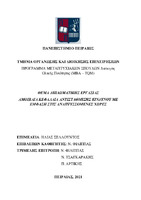Αμοιβαία κεφάλαια αντιστάθμισης κινδύνου με έμφαση στις αναπτυσσόμενες χώρες

View/
Keywords
Αντισταθμιστικά κεφάλαια ; Αμοιβή διαχείρισης ; High water mark ; Αμοιβή κινήτρου ; Στρατηγικές hedge funds ; Αναπτυσσόμενες χώρεςAbstract
Hedge Funds were first seen in the United States, 70 years ago, and up to date they manage
a vast volume of capitals. Their aims is risk hedging and profitability through the
implementation of a series of strategies that can be implemented both as a single approach
or through the utilization of a series of different strategies so as to maximize the portfolio
profitability. Although, there is a negative criticism regarding these funds, their continuous
growth trend and profitability have turned a percentage of investors towards them.
Hedge funds do not have a specific framework, within which, they operate, thus a number
of developing and developed countries have set rules, as to how they can operate, so as to
avoid speculative moves that might endanger the local economy.
The knowledge as to what a Hedge Fund really is, as well as their different strategies that
they can use, has been the focus of this research. In an effort to understand Hedge Funds
both in the way that they operate as well as, in the developing countries content has led to
the search of discovering the level of understanding of the citizen in relation to them.
This study examined the knowledge of the basic concepts of Hedge Funds, as well as, the
different strategies, the advantages and the perceived profiles of the investors. The results
showed that a significant percentage of participants did not have a basic knowledge of these
types of funds, while at the same time their understanding of what type of investors are
interested in them was diametrically opposite to the concept of hedging and profitability.


